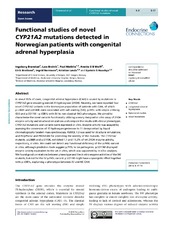Functional studies of novel CYP21A2 mutations detected in Norwegian patients with congenital adrenal hyperplasia
Brønstad, Ingeborg; Breivik, Lars Ertesvåg; Methlie, Paal; Wolff, Anette Susanne Bøe; Bratland, Eirik; Nermoen, Ingrid; Løvås, Kristian; Husebye, Eystein Sverre
Peer reviewed, Journal article
Published version
Permanent lenke
https://hdl.handle.net/1956/9782Utgivelsesdato
2014Metadata
Vis full innførselSamlinger
Originalversjon
https://doi.org/10.1530/ec-14-0032Sammendrag
In about 95% of cases, congenital adrenal hyperplasia (CAH) is caused by mutations in CYP21A2 gene encoding steroid 21-hydroxylase (21OH). Recently, we have reported four novel CYP21A2 variants in the Norwegian population of patients with CAH, of which p.L388R and p.E140K were associated with salt wasting (SW), p.P45L with simple virilising (SV) and p.V211MCp.V281L with SV to non-classical (NC) phenotypes. We aimed to characterise the novel variants functionally utilising a newly designed in vitro assay of 21OH enzyme activity and structural simulations and compare the results with clinical phenotypes. CYP21A2 mutations and variants were expressed in vitro. Enzyme activity was assayed by assessing the conversion of 17-hydroxyprogesterone to 11-deoxycortisol by liquid chromatography tandem mass spectroscopy. PyMOL 1.3 was used for structural simulations, and PolyPhen2 and PROVEAN for predicting the severity of the mutants. The CYP21A2 mutants, p.L388R and p.E140K, exhibited 1.1 and 11.3% of wt 21OH enzyme activity, respectively, in vitro. We could not detect any functional deficiency of the p.P45L variant in vitro; although prediction tools suggest p.P45L to be pathogenic. p.V211M displayed enzyme activity equivalent to the wt in vitro, which was supported by in silico analyses. We found good correlations between phenotype and the in vitro enzyme activities of the SW mutants, but not for the SV p.P45L variant. p.V211M might have a synergistic effect together with p.V281L, explaining a phenotype between SV and NC CAH.

